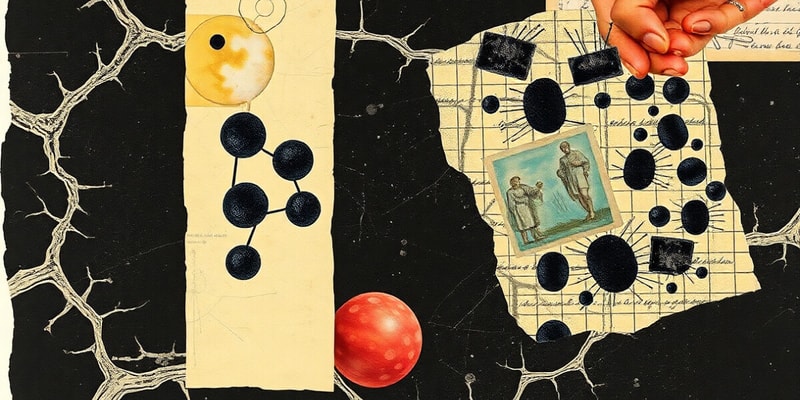Podcast
Questions and Answers
What is the role of hydrogen bonds in DNA structure?
What is the role of hydrogen bonds in DNA structure?
Hydrogen bonds connect complementary base pairs, stabilizing the double helix structure.
Explain the significance of the antiparallel orientation of DNA strands.
Explain the significance of the antiparallel orientation of DNA strands.
The antiparallel nature allows for proper alignment of hydrogen bonds between the base pairs.
What observation did Chargaff make regarding base pair proportions?
What observation did Chargaff make regarding base pair proportions?
Chargaff observed that the proportions of adenine to thymine and guanine to cytosine are equal.
How does the analogy of sorting yarn relate to DNA replication in cells?
How does the analogy of sorting yarn relate to DNA replication in cells?
Signup and view all the answers
What is the role of helicase in DNA replication?
What is the role of helicase in DNA replication?
Signup and view all the answers
Define a gene in the context of DNA and inheritance.
Define a gene in the context of DNA and inheritance.
Signup and view all the answers
How does the leading strand differ from the lagging strand during DNA replication?
How does the leading strand differ from the lagging strand during DNA replication?
Signup and view all the answers
What is the structure of the DNA backbone comprised of?
What is the structure of the DNA backbone comprised of?
Signup and view all the answers
Why is it essential for human cells to separate 3 billion base pairs evenly during division?
Why is it essential for human cells to separate 3 billion base pairs evenly during division?
Signup and view all the answers
What function do single-strand binding proteins serve during DNA replication?
What function do single-strand binding proteins serve during DNA replication?
Signup and view all the answers
Describe how the double helix of DNA resembles a ladder.
Describe how the double helix of DNA resembles a ladder.
Signup and view all the answers
What initiates the synthesis of the lagging strand?
What initiates the synthesis of the lagging strand?
Signup and view all the answers
In which direction is the leading strand synthesized?
In which direction is the leading strand synthesized?
Signup and view all the answers
What role does RNA primer play in DNA replication?
What role does RNA primer play in DNA replication?
Signup and view all the answers
What type of replication does DNA undergo, and what does this mean?
What type of replication does DNA undergo, and what does this mean?
Signup and view all the answers
What role do receptor proteins play in cellular function?
What role do receptor proteins play in cellular function?
Signup and view all the answers
Describe the relationship between mRNA and protein synthesis.
Describe the relationship between mRNA and protein synthesis.
Signup and view all the answers
What is the purpose of transcription in protein synthesis?
What is the purpose of transcription in protein synthesis?
Signup and view all the answers
How does the process of transcription differ from DNA replication?
How does the process of transcription differ from DNA replication?
Signup and view all the answers
Identify the main enzyme involved in the transcription process and its function.
Identify the main enzyme involved in the transcription process and its function.
Signup and view all the answers
What is the significance of proteins in cellular activities?
What is the significance of proteins in cellular activities?
Signup and view all the answers
Explain how gene expression can be regulated by cells.
Explain how gene expression can be regulated by cells.
Signup and view all the answers
Why is it important that RNA molecules are single-stranded?
Why is it important that RNA molecules are single-stranded?
Signup and view all the answers
What are the two main types of chromosomes in humans, and how are they categorized?
What are the two main types of chromosomes in humans, and how are they categorized?
Signup and view all the answers
Explain the term 'haploid number' and its relevance in human reproduction.
Explain the term 'haploid number' and its relevance in human reproduction.
Signup and view all the answers
Describe the structure of a chromosome in terms of sister chromatids and centromere.
Describe the structure of a chromosome in terms of sister chromatids and centromere.
Signup and view all the answers
What role do histones play in the structure of chromosomes?
What role do histones play in the structure of chromosomes?
Signup and view all the answers
Illustrate how chromatin changes during cell division.
Illustrate how chromatin changes during cell division.
Signup and view all the answers
Differentiate between somatic cells and gametes in terms of chromosome number.
Differentiate between somatic cells and gametes in terms of chromosome number.
Signup and view all the answers
What are telomeres, and what is their function?
What are telomeres, and what is their function?
Signup and view all the answers
Explain why the size and number of chromosomes can vary among different species.
Explain why the size and number of chromosomes can vary among different species.
Signup and view all the answers
What is the primary purpose of mitosis in somatic cells?
What is the primary purpose of mitosis in somatic cells?
Signup and view all the answers
Explain the term 'semiconservative' in the context of DNA replication.
Explain the term 'semiconservative' in the context of DNA replication.
Signup and view all the answers
How many DNA molecules are generated after one complete round of DNA replication?
How many DNA molecules are generated after one complete round of DNA replication?
Signup and view all the answers
Identify the role of parental DNA strands during DNA replication.
Identify the role of parental DNA strands during DNA replication.
Signup and view all the answers
What happens to the nucleotide strands in a DNA molecule prior to replication?
What happens to the nucleotide strands in a DNA molecule prior to replication?
Signup and view all the answers
Describe the significance of the original parent strand in the daughter molecules formed after replication.
Describe the significance of the original parent strand in the daughter molecules formed after replication.
Signup and view all the answers
In DNA replication, what role do the newly synthesized strands play?
In DNA replication, what role do the newly synthesized strands play?
Signup and view all the answers
How does the DNA structure support its ability to replicate semiconservatively?
How does the DNA structure support its ability to replicate semiconservatively?
Signup and view all the answers
What would be the consequence if DNA replication were not semiconservative?
What would be the consequence if DNA replication were not semiconservative?
Signup and view all the answers
What is the significance of adenine pairing with thymine and cytosine pairing with guanine in DNA?
What is the significance of adenine pairing with thymine and cytosine pairing with guanine in DNA?
Signup and view all the answers
What role do ribosomes play in the rough endoplasmic reticulum?
What role do ribosomes play in the rough endoplasmic reticulum?
Signup and view all the answers
How does the smooth endoplasmic reticulum differ structurally from the rough endoplasmic reticulum?
How does the smooth endoplasmic reticulum differ structurally from the rough endoplasmic reticulum?
Signup and view all the answers
What is the primary function of vesicles in the cell?
What is the primary function of vesicles in the cell?
Signup and view all the answers
What is the nuclear envelope and what is its primary function?
What is the nuclear envelope and what is its primary function?
Signup and view all the answers
Describe the composition of chromatin and its significance.
Describe the composition of chromatin and its significance.
Signup and view all the answers
What is the function of nucleoli within the nucleus?
What is the function of nucleoli within the nucleus?
Signup and view all the answers
How do chloroplasts contribute to plant cells?
How do chloroplasts contribute to plant cells?
Signup and view all the answers
What are the primary functions of the central vacuole in plant cells?
What are the primary functions of the central vacuole in plant cells?
Signup and view all the answers
What distinguishes the size and function of the nucleus compared to other organelles?
What distinguishes the size and function of the nucleus compared to other organelles?
Signup and view all the answers
What metabolic processes occur within the smooth endoplasmic reticulum?
What metabolic processes occur within the smooth endoplasmic reticulum?
Signup and view all the answers
Study Notes
Cell Part Structure and Functions
- Rough endoplasmic reticulum (RER): Membrane system with cisternae, studded with ribosomes; involved in protein synthesis and modification.
- Smooth endoplasmic reticulum (SER): Membrane system of sacs and tubules, lacks ribosomes; involved in lipid synthesis, metabolism, and detoxification.
- Vesicles: Small membrane-bound organelles for transport of molecules within the cell.
- Nucleus: Largest organelle; contains nucleoplasm, nucleolus, and chromatin (DNA & proteins); controls cell activities.
- Chromatin: Granular material made of DNA and histone proteins; contains genes.
- Nuclear envelope: Double-membrane structure that encloses the nucleus; contains pores regulating material exchange.
- Nucleolus: Dense, spherical bodies within the nucleus; make ribosome components.
- Central vacuole (plant cells): Large membrane-bound compartment in plant cells for storage of substances, waste, and pigments, providing structural support.
- Chloroplasts (plant cells): Membrane-enclosed organelle containing chlorophyll-containing structures (grana) for photosynthesis.
DNA Structure and Function
- DNA is a double-stranded helix, containing four bases: adenine (A), thymine (T), guanine (G), and cytosine (C). A pairs with T and G pairs with C.
- Nucleotides are the building blocks of DNA; each has a pentose sugar, phosphate group, and nitrogenous base.
- DNA is the hereditary material
- There is a 5' end and a 3' end
- DNA is packaged in chromosomes in the nucleus (humans have 46 chromosomes)
- DNA is replicated during cell division (semiconservative).
- DNA directs protein synthesis through transcription and translation.
Chromosome Structure
- Chromosomes contain DNA and proteins (histones)
- Chromosomes are organized in chromatin (unwound DNA) as well as supercoiling (compaction)
- Humans have 46 chromosomes; 22 pairs are autosomes and 1 pair is sex chromosomes (XY)
- Sister chromatids are identical copies of each other, and are joined at the centromere.
- Chromosome arms are p (short) and q (long)
- Telomeres are the ends of chromosomes; important for structure and stability
Studying That Suits You
Use AI to generate personalized quizzes and flashcards to suit your learning preferences.
Related Documents
Description
Test your knowledge on the functions and structures of various cell parts, including the rough and smooth endoplasmic reticulum, nucleus, and vesicles. This quiz will help reinforce your understanding of cell biology concepts.



